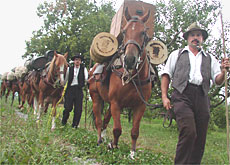Will Obwalden become a rags-to-riches story?

swissinfo pays a visit to Switzerland's newest tax haven but finds few signs of affluence in the small mountainous canton.
Obwalden has just lowered its taxes to attract wealthy incomers, but is still coming to terms with its impoverished past.
The new tax regime approved by voters in December came into effect on January 1, turning the canton with the highest taxes into the one with the lowest rates.
But will this mark the beginning of a prosperous chapter in a canton that was always among Switzerland’s poorest, and has recorded below average growth in the modern age?
A special exhibition titled “Migration” at Obwalden’s history museum chronicles how not so long ago the only hope of striking it rich was to buy a one-way ticket abroad.
It tells the story of crop failure, famine and soup kitchens and portrays Obwalden émigrés who settled in Imperial Valley in California and other parts of the United States, Canada and Brazil, having taken part in the mass exodus at the end of the 19th and beginning of the 20th century.
The idea that Obwalden could one day attract wealthy individuals and corporations is at odds with the reality that the Swiss canton once had the highest percentage of emigration per capita after Italian-speaking Ticino.
“You can still see the old burgher houses in the capital, Sarnen, and neighbouring town of Sachseln or the big old hotels built during the tourist boom at the end of the 19th century,” says historian, Niklaus von Flüe.
Exodus
“But if you want to understand more about the exodus, then you have to visit villages such as Alpnach and Giswil to see well-preserved farmhouses where you can imagine how hard life once was.”
It is not as if Obwalden’s past has caught up with it. Closer to the truth is the fact that the canton’s modest economic growth has been insufficient to radically alter its architectural landscape.
Von Flüe says the tall, decorative burgher houses were built by the handful of merchants who controlled the local salt trade and returning mercenaries, who had fought under various flags of French and Italian monarchs.
Each summer, locals revive the ancient trading route, leading pack animals laden with salt and cheese on the arduous journey over the mountain passes between Obwalden and northern Italy.
The valuable salt was considered white gold and was guarded in the cellar of Sarnen’s town hall, which dominates the central square.
Von Flüe points to a cylindrical post made of stone on the building’s outer wall. He says this is where up until the beginning of the 19th century transgressors where chained and tortured.
An iron shackle still hangs from the post, but the wooden pillory has been long removed and is now on display in the history museum, beside the executioner’s sword and near broad scales for weighing salt.
Witches’ tower
The slim “witches’ tower” behind the town hall is the last remaining building of its kind in Switzerland dating from the late 13th century, the period when the Swiss confederation was founded.
It houses the White Book of Sarnen, the only remaining collection of official documents referring to the founding treaties.
With the exception of a couple of ski resorts, Obwalden’s heritage is its tourist capital, and the main attraction for more than 500 years now has been the hermitage of Switzerland’s only saint, Niklaus von Flüe, remembered as Brother Klaus.
“In the years following his beatification in 1947, the pilgrimage reached its apex with thousands of people coming to worship here each year,” says his namesake and descendant during a visit to the saint’s two-storey wooden house in Flüeli-Ranft.
The picturesque hamlet sits on an idyllic shelf a few hundred metres above Sarnen. A path leads down to the chapel where the 15th century hermit fasted for 20 years.
Brother Klaus is remembered as a great mystic and arbitrator, whose counsel prevented civil war from breaking out in 1481.
The last big project in Flüeli-Ranft was the construction of a grand hotel at the turn of the 20th century.
It has been nearly 100 years since the end of the Belle Époque, the period considered tourism’s golden age. High time for a new golden era to dawn for Obwalden.
swissinfo, Dale Bechtel in Sarnen
Obwalden, in central Switzerland, has a population of 33,000.
Just under a third of its residents living in the capital, Sarnen.
Only 16.6% of its workforce has a higher education, 5% less than the national average.
14% are employed in agriculture – nearly three times the Swiss average.
As “Unterwalden” (together with Nidwalden), it was one of the three founding Swiss cantons.
Voters in Obwalden approved a new degressive tax regime which came into effect on January 1.
Individuals earning up to SFr70,000 will in future pay 8 to 10% less personal tax.
Those earning up to SFr300,000 will be taxed up to 6%, while those in the highest bracket will see their burden sink from 2.35% to 1%.
The cantonal property tax has dropped by at least 30% and the 6.6% corporate tax is now the lowest in Switzerland.

In compliance with the JTI standards
More: SWI swissinfo.ch certified by the Journalism Trust Initiative












You can find an overview of ongoing debates with our journalists here . Please join us!
If you want to start a conversation about a topic raised in this article or want to report factual errors, email us at english@swissinfo.ch.